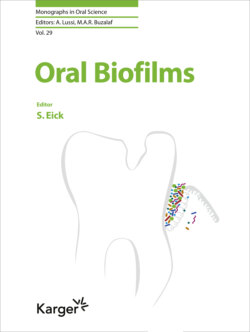Читать книгу Oral Biofilms - Группа авторов - Страница 21
Dental Biofilm and Diseases
ОглавлениеMicrobial homeostasis can break down and result in restructuring of the biofilm with a different composition [35]. The most prevalent oral diseases, dental caries, and periodontitis are multi-species biofilm-associated diseases.
For many years, dental caries has been strongly associated with S. mutans, which utilizes many carbohydrates to produce acids and to synthesize extracellular polysaccharides, an important constituent of the matrix of cariogenic biofilm [29]. Nowadays, caries is seen as a result of a dysbiosis induced by environmental factors [40]. Microorganisms metabolize sugar supplied by food and create an acidic environment where aciduric bacteria (including mutans streptococci) become dominant, which leads to the demineralization of enamel and dentine [41]. Then, the bacterial-induced acidification also activates host-derived proteases, which contribute to the degradation of the organic matrix of dentine and of the root surface [42]. Using the Shannon index as a measure of diversity and evenness in the microbiome, a higher diversity is found in healthy individuals than in those with caries disease in general, but streptococci were enriched in the cohort with caries [34]. In caries-positive adolescence, the presence of S. mutans is associated with a lower diversity, while if S. mutans is not present many other saccharolytic species occur [43]. Functional profiles detect more sugar uptake systems and more systems associated with antimicrobial resistance in the microbiomes of caries-positive than in healthy individuals [34]. When comparing samples with active dentine caries with enamel caries and healthy samples, diversity values were higher for dentine caries, although in a few samples only a very low diversity was found [44].
The pathogenesis of periodontitis is thought to be an inflammatory response to a dysbiotic microbiota in the subgingival biofilm [45]. P. gingivalis has been postulated as being a keystone pathogen, it drives the development of the microbial shifts, and causes dysbiosis and inflammation by modulating the host response [46]. A systematic review summarizing the published data of complex analyses of the periodontal microbiota found high evidence for P. gingivalis, T. forsythia, T. denticola, F. alocis, TM7 spp., and Desulfobulbus spp. being more abundant in periodontal disease than in periodontal health [47]. Shannon index results did not reveal clear differences between periodontal health and disease [48]. Functional analysis found a higher abundance of genes involved with bacterial motility, lipopolysaccharide biosynthesis, and peptidase in the subgingival metagenome of subjects with periodontitis [48].
In the oral cavity, biofilms are formed not only on natural teeth but also on restorative materials, prosthetic constructions, and dental implants. The biofilm formation is very similar, although in detail distinct differences occur. For example, a biofilm at an implant is less diverse than one at a tooth, and abundances of the species differ between both biofilms [49].
